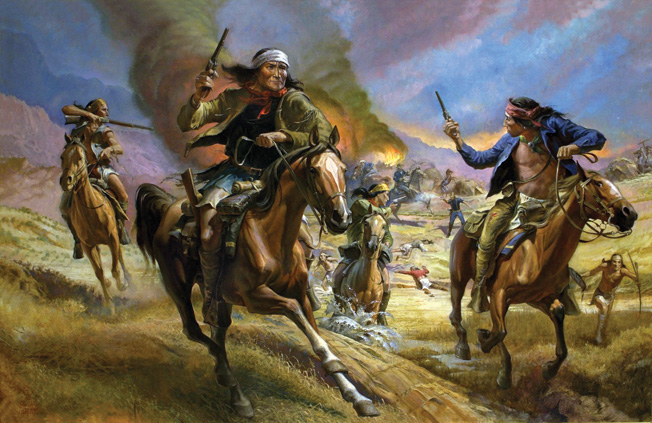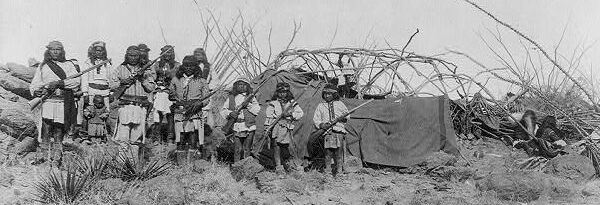
Echoes in the Mesas: The Enduring Legends of America’s Apache Wars in New Mexico
New Mexico’s rugged, sun-baked landscapes whisper tales of a fierce, unyielding past. From the stark beauty of the Chihuahuan Desert to the pine-clad peaks of the Mogollon Mountains, the land itself seems to remember the thunder of hooves, the crack of rifles, and the indomitable spirit of a people fighting for their ancestral home. These are the lands where the legends of America’s Apache Wars were forged, a brutal and protracted conflict that pitted the United States Army against some of the most skilled and tenacious warriors the continent has ever known. More than just historical events, the Apache Wars, particularly those centered in New Mexico, have etched themselves into the fabric of American myth, embodying themes of freedom, resistance, conquest, and the tragic clash of cultures.
The Apache, a collective term for several culturally related Native American tribes, had for centuries roamed the vast expanses of what is now New Mexico, Arizona, and parts of Texas, Sonora, and Chihuahua. They were masters of the arid environment, nomadic hunters and raiders, whose lives were intrinsically tied to the rhythm of the land. Their independence and warrior culture, honed over generations of conflict with rival tribes and later with Spanish and Mexican settlers, would prove to be an almost insurmountable challenge for the burgeoning American nation.
The arrival of Anglo-American settlers in the mid-19th century, following the Mexican-American War and the Gadsden Purchase, marked a catastrophic turning point. Driven by "Manifest Destiny" and the lure of gold and land, these newcomers brought with them an alien concept of property, a different legal system, and an insatiable desire for expansion. The Apache, who viewed the land as a communal resource to be respected and defended, soon found themselves in direct conflict with this relentless tide.

The Spark of Conflict: Betrayal and Bloodshed
While the Apache Wars are often painted with a broad brush, their origins are deeply rooted in specific acts of betrayal and misunderstanding. One of the earliest and most pivotal figures in the New Mexico theater was Mangas Coloradas (Red Sleeves), a towering Mimbreño Apache chief renowned for his intelligence, leadership, and imposing physical presence. Initially, Mangas Coloradas sought a peaceful coexistence, even engaging in trade with American miners and settlers around the Santa Rita del Cobre copper mines in southwestern New Mexico.
However, the fragile peace shattered in 1851 when a group of American miners, without provocation, ambushed and brutally flogged Mangas Coloradas. This humiliation of a revered leader ignited a simmering resentment into open warfare. "This act," wrote historian Dan L. Thrapp, "was probably the single most important factor in bringing on the bloody Apache wars." Mangas Coloradas, along with his son-in-law Cochise of the Chiricahua Apache, would spend the next decade exacting a terrible revenge, becoming legendary for their strategic brilliance and the ferocity of their attacks.
The American Civil War briefly diverted military resources, offering the Apache a reprieve, but it also saw Mangas Coloradas’s final, tragic act. In 1863, seeking peace talks under a flag of truce, he was lured into a trap by Brigadier General Joseph West, commander of the Department of New Mexico, at Fort McLane. Despite promises of safety, Mangas Coloradas was brutally tortured and murdered by soldiers while ostensibly attempting to escape. His scalp was taken as a trophy. This despicable act further cemented Apache distrust and fueled a cycle of violence that would last for decades.
The Reservation System: A Cage for Eagles
Following the Civil War, the U.S. government’s policy towards Native Americans crystallized around the concept of reservations – tracts of land where tribes were expected to settle, abandon their traditional ways, and adopt an agrarian lifestyle. For the nomadic Apache, this was a death sentence. The reservations were often on infertile land, far from traditional hunting grounds, and plagued by corruption among Indian agents who siphoned off supplies meant for the tribes. Disease, starvation, and boredom became rampant.
The Apache’s inherent love of freedom and the dire conditions on the reservations led to constant breakouts. This cycle of escape, pursuit, and forced return defined much of the later Apache Wars. New Mexico’s vast, unforgiving terrain became both a sanctuary and a battleground for these "renegade" bands. The Mogollon Mountains, the Black Range, and the hidden canyons of the Gila Wilderness provided ideal cover for warriors who knew every rock, every water source, and every shadow.
Victorio and the Iron Will of the Warm Springs Apache

Among the most formidable leaders to emerge from the reservation system’s failures was Victorio of the Warm Springs (or Ojo Caliente) Apache. A contemporary of Mangas Coloradas and Cochise, Victorio was a respected warrior and a man of his word. His band, repeatedly moved from their ancestral lands near Ojo Caliente, New Mexico, to distant, inhospitable reservations, grew increasingly desperate.
In 1879, pushed beyond endurance by broken promises and the threat of forced relocation to the notorious San Carlos Reservation in Arizona, Victorio led his people off the reservation for the last time. What followed was "Victorio’s War," a two-year campaign of masterful guerrilla warfare across New Mexico, Texas, and Mexico. With a small band of warriors, Victorio outmaneuvered, outfought, and outsmarted significantly larger forces of U.S. and Mexican troops. He became a legend for his tactical genius, his ability to appear and disappear like a phantom, and his unwavering commitment to his people’s freedom.
Victorio’s raids targeted settlements, supply trains, and military outposts, often inflicting heavy casualties while suffering few themselves. His knowledge of the terrain was unparalleled, using the mountains and deserts of New Mexico as his personal fortress. Tragically, in October 1880, after countless engagements, Victorio and many of his followers were cornered and killed by Mexican forces under Colonel Joaquin Terrazas at Tres Castillos in Chihuahua, Mexico, a devastating blow to the Warm Springs Apache and a somber chapter in New Mexico’s history.
Geronimo: The Embodiment of Resistance
Perhaps the most iconic figure to emerge from the Apache Wars, and certainly the one whose name resonates most deeply in American legend, is Geronimo (Goyaałé, "one who yawns"). Though a Chiricahua Apache, his campaigns frequently spilled into and centered around New Mexico. Geronimo was not a hereditary chief but a respected medicine man and a skilled warrior whose personal vendetta against Mexicans and later Americans fueled his relentless fight. The murder of his family by Mexican soldiers in 1858 left him with an unquenchable thirst for vengeance and a deep-seated distrust of outsiders.
Geronimo’s repeated escapes from the San Carlos Reservation, often with small bands of loyal followers, became the stuff of legend. For years, he and his warriors, including women and children, led thousands of U.S. Army soldiers and Mexican troops on a relentless chase across the vast, rugged landscapes of New Mexico, Arizona, and northern Mexico. His ability to evade capture, his cunning, and his sheer will to resist seemed supernatural to his pursuers.
General George Crook, a seasoned Indian fighter, understood the futility of conventional warfare against the Apache. He famously employed Apache scouts, a controversial but effective strategy, to track and engage the "renegades." These scouts, often from rival bands or those who saw their future intertwined with the Americans, provided invaluable knowledge of the terrain and Apache tactics. Even with their help, Geronimo proved incredibly elusive.
In 1886, after a harrowing pursuit involving approximately 5,000 U.S. Army soldiers (nearly a quarter of the entire U.S. Army at the time), 500 Apache scouts, and thousands of Mexican troops, Geronimo and his last band of 38 men, women, and children finally surrendered to General Nelson A. Miles at Skeleton Canyon, Arizona, just west of the New Mexico border. This was not a defeat in battle but a surrender born of attrition, exhaustion, and the grim realization that further resistance was impossible.
The End of an Era and a Lingering Legacy
Geronimo’s surrender marked the symbolic end of the Apache Wars, and indeed, the last major Native American armed resistance against the United States. The consequences for the Chiricahua Apache were severe. Despite promises of a return to their homelands, Geronimo and his band, along with the Apache scouts who had helped capture him, were exiled to Florida, then Alabama, and finally to Fort Sill, Oklahoma. They never saw their ancestral lands in New Mexico again.
The legends of the Apache Wars in New Mexico endure, shaping both regional identity and the broader American narrative. They are complex legends, often seen through different lenses. To some, the Apache warriors were brutal savages, an impediment to progress and civilization. To others, they were courageous freedom fighters, defending their land and way of life against overwhelming odds.
Today, their stories are woven into the very fabric of New Mexico. Place names like Victorio Peak, Geronimo Trail, and Mangas Creek serve as constant reminders of the conflict. The Apache people themselves, though greatly diminished and irrevocably changed, still live in New Mexico, carrying forward their rich cultural heritage and their ancestors’ legacy of resilience. The Mescalero Apache Reservation, for instance, stands as a testament to their enduring presence.
The Apache Wars in New Mexico are more than just historical events; they are a profound moral drama about land, freedom, and identity. They remind us of the immense human cost of expansion, the tragic consequences of broken treaties, and the extraordinary courage of those who chose to fight to the bitter end. As the wind whispers through the canyons and across the mesas of New Mexico, it carries the echoes of these legends—a timeless testament to a fierce struggle for survival and the enduring spirit of a people who refused to be broken.


